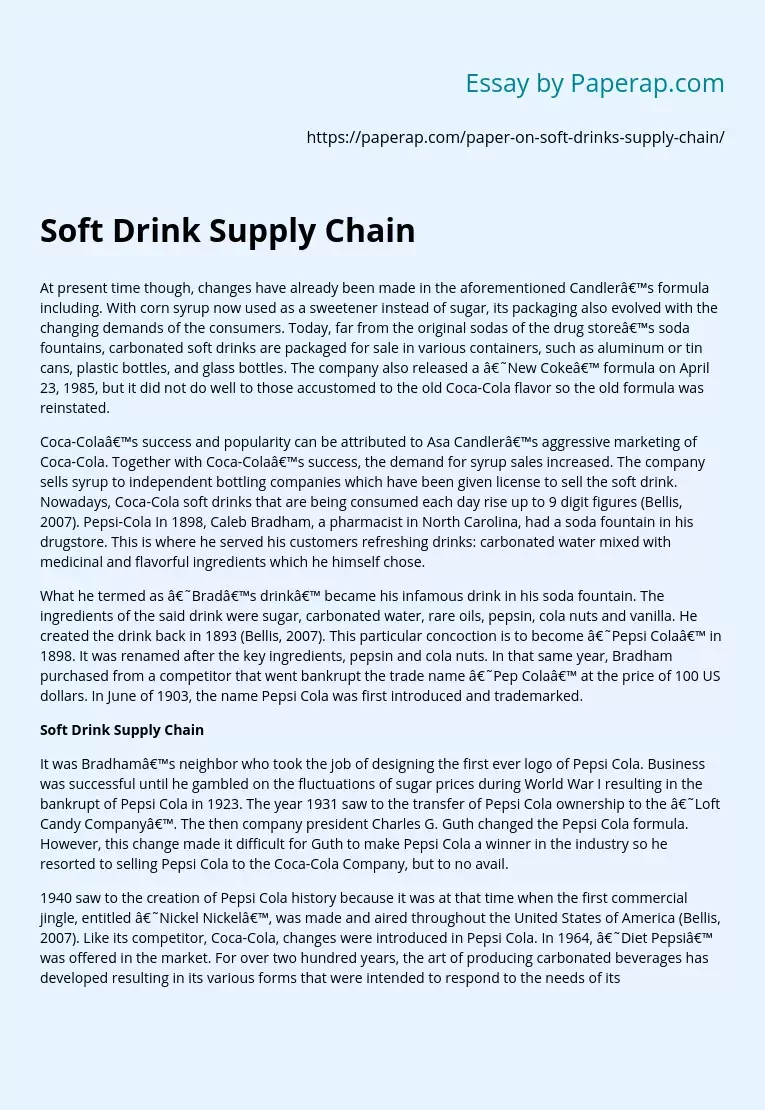Soft Drink Supply Chain
At present time though, changes have already been made in the aforementioned Candler’s formula including. With corn syrup now used as a sweetener instead of sugar, its packaging also evolved with the changing demands of the consumers. Today, far from the original sodas of the drug store’s soda fountains, carbonated soft drinks are packaged for sale in various containers, such as aluminum or tin cans, plastic bottles, and glass bottles. The company also released a ‘New Coke’ formula on April 23, 1985, but it did not do well to those accustomed to the old Coca-Cola flavor so the old formula was reinstated.
Coca-Cola’s success and popularity can be attributed to Asa Candler’s aggressive marketing of Coca-Cola. Together with Coca-Cola’s success, the demand for syrup sales increased. The company sells syrup to independent bottling companies which have been given license to sell the soft drink. Nowadays, Coca-Cola soft drinks that are being consumed each day rise up to 9 digit figures (Bellis, 2007).
Pepsi-Cola In 1898, Caleb Bradham, a pharmacist in North Carolina, had a soda fountain in his drugstore. This is where he served his customers refreshing drinks: carbonated water mixed with medicinal and flavorful ingredients which he himself chose.
What he termed as ‘Brad’s drink’ became his infamous drink in his soda fountain. The ingredients of the said drink were sugar, carbonated water, rare oils, pepsin, cola nuts and vanilla. He created the drink back in 1893 (Bellis, 2007). This particular concoction is to become ‘Pepsi Cola’ in 1898. It was renamed after the key ingredients, pepsin and cola nuts.
In that same year, Bradham purchased from a competitor that went bankrupt the trade name ‘Pep Cola’ at the price of 100 US dollars. In June of 1903, the name Pepsi Cola was first introduced and trademarked.
Soft Drink Supply Chain
It was Bradham’s neighbor who took the job of designing the first ever logo of Pepsi Cola. Business was successful until he gambled on the fluctuations of sugar prices during World War I resulting in the bankrupt of Pepsi Cola in 1923. The year 1931 saw to the transfer of Pepsi Cola ownership to the ‘Loft Candy Company’. The then company president Charles G. Guth changed the Pepsi Cola formula. However, this change made it difficult for Guth to make Pepsi Cola a winner in the industry so he resorted to selling Pepsi Cola to the Coca-Cola Company, but to no avail.
1940 saw to the creation of Pepsi Cola history because it was at that time when the first commercial jingle, entitled ‘Nickel Nickel’, was made and aired throughout the United States of America (Bellis, 2007). Like its competitor, Coca-Cola, changes were introduced in Pepsi Cola. In 1964, ‘Diet Pepsi’ was offered in the market. For over two hundred years, the art of producing carbonated beverages has developed resulting in its various forms that were intended to respond to the needs of its customers.
Through its evolution, it has covered various economies of the nation’s industries as key sources of materials and services in the manufacturing of soft drinks. This meant that as the soft drink industry grew, the other industries in the soft drink supply chain grew as well. These industries in the supply chain are the manufacturers of artificial sweetening agent, edible acids, natural or artificial flavors, and other key ingredients that the industry needs in its manufacture of soft drinks.
Machinery and packaging services also benefited from the soft drink industry’s success. In the face of the challenges of conforming to the ever changing needs of the customers throughout its history, the soft drink industry have introduced different packagings, from glass bottles with corresponding cork crowns, soft drink cartons called ‘Hom-Paks’ in the 1920’s, aluminum cans, plastic bottles and today, the use of PET (Polyethylene Terephthalate) bottles.
Also together with these changes, the manufacturers of soft drinks amended their syrup mixture to surmount the rising cost of its key materials. Major changes were made on its sweetening agents to counter the rising cost of sugar and to conform to consumer’s approval. From Saccharin to Nutra-Sweet, now corn syrup replaced sugar as an ingredient to soft drinks.
Soft Drink Supply Chain. (2019, Dec 05). Retrieved from https://paperap.com/paper-on-soft-drinks-supply-chain/

